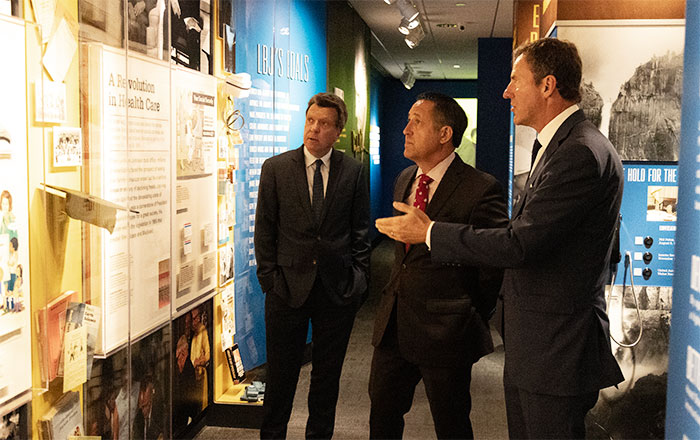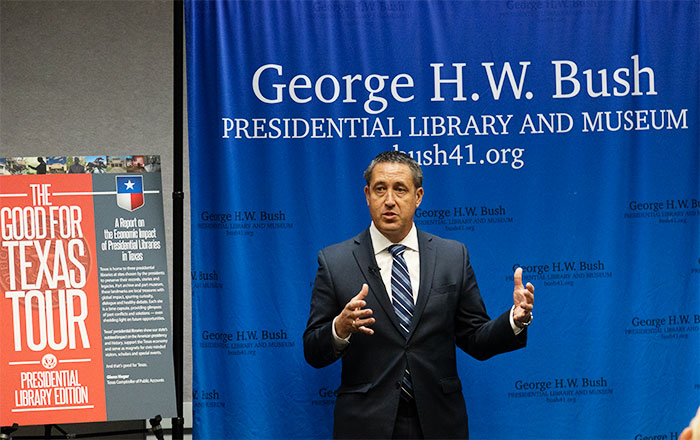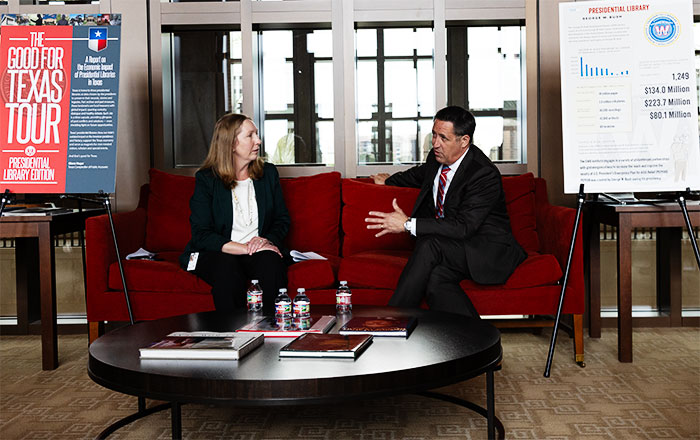economicsPresidential libraries preserve history, provide economic boost
Comptroller highlights Texas’ presidential treasures
June 2024 | Morgan Hecht and Astrid Alvarado

Home to three presidential libraries, the most of any state, Texas plays a key role in preserving U.S. history through the Lyndon B. Johnson Presidential Library and Museum in Austin, the George H.W. Bush Presidential Library and Museum in College Station and the George W. Bush Presidential Center in Dallas. Texas Comptroller Glenn Hegar highlighted their significant cultural and economic impact in his Good for Texas Tour: Presidential Libraries Edition.
“Texas’ presidential libraries show our state’s outsize impact on the American presidency and history, support the Texas economy and serve as magnets for civic-minded visitors, scholars and special events,” says Hegar.
Documents and mementos related to pivotal events in U.S. history such as the Vietnam War, the Gulf War and 9/11 are in these libraries, which not only serve as reminders of the past, but also provide economic and educational resources.
- From 2014 to 2023, Texas’ presidential libraries had more than 4.3 million visitors (Exhibit 1).
- Texas houses a collective 159 million pages of documents related to U.S. presidencies.
- In 2023, the Texas presidential libraries provided more than $329 million of the state’s gross domestic product.
Exhibit 1 data
| Fiscal Year | Johnson | Bush (41) | Bush (43) |
|---|---|---|---|
| 2014 | 139,026 | 136,101 | 490,887 |
| 2015 | 173,815 | 146,815 | 300,333 |
| 2016 | 154,238 | 149,489 | 210,989 |
| 2017 | 152,583 | 149,614 | 218,879 |
| 2018 | 152,475 | 186,782 | 185,735 |
| 2019 | 145,202 | 232,902 | 174,450 |
| 2020* | 70,225 | 80,714 | 61,656 |
| 2021* | 3,373 | 0 | 22,843 |
| 2022 | 84,354 | 101,920 | 75,838 |
| 2023 | 118,885 | 101,960 | 97,500 |
* Libraries closed most of fiscal year due to Covid-19 pandemic
Sources: George H.W. Bush Presidential Library; George W. Bush Presidential Center; Lyndon B. Johnson Presidential Library; U.S. National Archives and Records Administration
National Archives and Records Administration History
The U.S. National Archives and Records Administration (NARA), which describes itself as the nation’s record-keeper, oversees the Presidential Library System (PLS). The PLS was created in 1939 when President Franklin Delano Roosevelt donated his personal and presidential papers and announced plans to build a presidential library on his Hyde Park, New York, estate using private funds. Congress accepted the facility as a part of NARA, which took over the operation and ownership of the Roosevelt Library; this became the model for all other presidential libraries. After President Harry S. Truman decided to build a library as well, Congress approved the Presidential Libraries Act in 1955, formally establishing the PLS.
Once a library is confirmed, a private nonprofit organization is created to raise the required funds and oversee the construction process. After the library is constructed, all operation and maintenance duties are handed over to NARA’s Office of Presidential Libraries. This office provides administrative and budgetary oversight for all libraries within the PLS and develops and implements policies for the libraries.
Highlights of Presidential Library Visits
Each of Texas’ presidential libraries boasts a unique history and assortment of artifacts and exhibits. Together, the libraries encapsulate the history and politics from 1937 — the beginning of Lyndon B. Johnson’s political career — to 2009 — the end of George W. Bush’s presidency. Combined, Texas’ libraries occupy more than 366,000 square feet of space (Exhibit 2).
| Library | Square Footage | Textual Records | Photography | Video Recordings | Library Artifacts | Electronic Information |
|---|---|---|---|---|---|---|
| Lyndon B. Johnson Presidential Library and Museum | 143,836 square feet | 45 million pages | 650,000 photos | 7500 video recordings | 53,853 artifacts | N/A |
| George H. W. Bush Presidential Library and Museum | 81,706 square feet | 44 million pages | 2 million photos | 10,000 video recordings | 61,271 artifacts | N/A |
| George W. Bush Presidential Library and Museum | 140,941 usable square feet | 70 million pages | 3.8 million photos | 30,000 audiovisual recordings | 43,000 artifacts | 80 terabytes |
| Total | 366,483 square feet | 159 million pages | 6.45 million photos | 47,500 video/audiovisual recordings | 158,124 artifacts | 80 terabytes |
Sources: George H.W. Bush Presidential Library; George W. Bush Presidential Center; Lyndon B. Johnson Presidential Library; U.S. National Archives and Records Administration
Lyndon B. Johnson Presidential Library and Museum

The Lyndon B. Johnson Presidential Library and Museum (LBJ Library) opened in 1971 to honor the historic legacy of the 36th president of the U.S. The LBJ Library is the largest presidential library in Texas and is located on the campus of The University of Texas at Austin; it is the first presidential library to be placed on a university campus. The LBJ Library holdings detail Johnson’s illustrious political career from U.S. representative to U.S. president, as well as the legacy of his wife, Lady Bird Johnson, including a replica of the Oval Office during LBJ’s presidency. In 2023, the LBJ Library contributed an estimated $82 million to the Texas economy, with a total direct and indirect employment of about 810 jobs.* “The LBJ Library is significant to the state as a reminder of the role that Texas has played at the national level,” says Mark Lawrence, director of the LBJ Library. “This study that the Comptroller’s office has done of the economic impact of the presidential libraries is a wonderful example of how we (federal and state offices) can collaborate.”
George H.W. Bush Presidential Library and Museum

Dedicated in 1997 on the Texas A&M University campus in College Station, the George H.W. Bush Presidential Library and Museum (Bush Library) will celebrate what would have been the 41st president’s centennial birthday this year with the official opening of a 29,000-square-foot building that houses a retired Marine One helicopter and the Union Pacific locomotive that carried Bush to his final resting place at the library. In 2023, the Bush Library contributed $113.2 million to the Texas economy, fueled by construction activity, maintenance and retail sales; and it directly or indirectly employed about 1,100 people. Bush Library Director Dawn Hammatt says, “The George H. W. Bush Presidential Library and Museum attracts visitors from around the world, bringing more than 60 percent of visitors and researchers from out of state often staying a few nights, and it is through these visits that they can learn about the history of the presidency, the Bush family and the history of Texas.” She goes on to say, “The library is uniquely situated to share the story of American democracy, and visitors can learn more of our shared experience during a time of monumental development in foreign policy.”
George W. Bush Presidential Center

Located on the campus of Southern Methodist University, the George W. Bush Presidential Center (Bush Center) is the second most visited presidential museum in the U.S., behind the Ronald Reagan Presidential Library in California. During the past decade, the 23-acre Bush Center, which is dedicated to the 43rd President of the United States, saw nearly 2 million visitors. The center also includes artifacts from pivotal parts of U.S. history, such as the bullhorn that George W. Bush famously used to unite Americans while visiting the site of 9/11 in 2001. In 2023, the Bush Center employed nearly 1,300 people both directly and indirectly and contributed an estimated $134 million toward the Texas economy. “The Center reflects the values that drive President and Mrs. Bush: freedom, opportunity, accountability and compassion,” says Ken Hersh, its CEO and president. “These values live inside our walls, from the artifacts preserved here to the policy recommendations coming out of the Bush Institute to the events on our stage. I believe these values are timeless and in the heart of every American, which means that as President Bush often says, Americans’ best days are always ahead of us.”
Impact of Presidential Libraries in Texas
In addition to the historical preservation, Texas’ three presidential libraries provide educational and community resources through their own foundations. Each Texas presidential library is accompanied by a public policy school or policy center.
- The LBJ Library established the LBJ Foundation, providing grant programs for research, speaker series related to policy and professional development programs such as the LBJ Women’s Campaign School. The LBJ School of Public Affairs offers master’s degrees in public affairs and global policy studies, an executive master’s degree in public leadership and a doctoral degree in public policy. Since its creation in 1972, the school has more than 4,400 alumni.
- The Bush Library is managed by the George and Barbara Bush Foundation. A main component of the foundation’s mission is to promote community service and advocacy, and it does so through grant programs and speakership series. The Bush School of Government and Public Service was created at Texas A&M in 1997 and offers master’s degrees in public service and administration, international affairs, and international policy. It has more than 750 alumni as of 2013.
- George W. Bush Institute, established in 2009, is a nonpartisan policy center dedicated to using a combination of research, leadership development and advocacy to address societal challenges. The institute continues former President Bush’s philanthropic partnerships that were established during his presidency. The Bush Institute is also home to the Laura Bush Foundation for American Libraries.
Outlook
New exhibits and buildings at the libraries will continue to welcome visitors, contributing to the Texas economy and preserving history into the future.
Editor’s note: Jobs data for the three libraries represent all direct and indirect employment, including full- and part-time employees as well as any employment in industries that supply inputs to the libraries, such as construction.
Read more about the presidential libraries in Texas, and Comptroller Hegar’s tour of the facilities, at Good for Texas Tour: Presidential Libraries.


